Useful tips from experienced florists
Over the entire period of petunia's existence, flower growers have accumulated rich experience in growing it and share it with beginners:
- The bushes are watered strictly at the root, without falling on the foliage and flowers. Spraying from a spray bottle is carried out in the evening so that the plant does not get sunburn.
- Waterlogging of the soil threatens the development of putrefactive processes.
- The long branches of the petunia are pinched to form a compact bush and to provide sufficient nourishment for the flowers and buds.
- To reduce the amount of dressing, the soil is mixed with a hydrogel. It absorbs and retains nutrients, which are then absorbed by the plant.
- The Starry sky hybrid does not lay seed pods and propagates exclusively by cuttings. If you see bags of seeds of this cultivar on sale, be aware that this is a fake.
- Dry and lethargic flowers are not left on the bush, but are cut off with sharp scissors.
- At the end of the flowering period, the shoots are cut to half to stimulate branching and flower buds.
- To save the petunia for the next year, by the onset of the first frost, the plants are transferred to individual pots and placed in a warm room. Dry and weak branches are cut, leaving 10 cm. Petunia successfully winters at a temperature of + 10 ... + 15 ° С and watering frequency 2 times a month.
Varieties of varieties and their photos
There are not so many varieties of this decorative petunia variety, but in 2017 German specialists bred new, very interesting petunia varieties. There are two of the most common hybrids today.
Photo of petunia "Night sky"
Petunia "Night Sky"
Hanging shoots branch, grow up to 1 m in length. Each shoot has numerous branches that grow rapidly, densely covered with endless buds. Early flowering, long lasting throughout the summer. The flowers themselves have an unusual color - dark blue, with a purple tint. Against this background, white blotches are located in a scattering of spots - asterisks.
Petunia "Doll"
It is distinguished by bright green foliage, the leaves are located close to each other, which allows petunias to grow in a beautiful dense weaving carpet. Very bright flowers are scattered across its field. The petals are bright pink, against their background drops glisten - interspersed with white.
This hybrid tolerates transplantation very well, "bears fruit" well - buds appear quickly and are abundantly located on branched shoots. Petunia "Doll" is unpretentious, feels good outdoors, decorates balconies, loggias and terraces.
Starry sky
Petunia Night Sky
Several new hybrids have very interesting coloration, reminiscent of the starry sky. The German ampelous petunia cultivar Night Sky, which received the 2015 FleuroStar Award, is distinguished by a unique spotted flower pattern, white spots scattered chaotically against a blue lavender background, as if the artist had sprayed paint from his brush. This variety is accompanied by Bonnie Mystery Sky with very small bright spots on a dark blue background.
Similar coloration in Czech hybrids of the Dot Star F1 series. They are available in two versions - with deep pink - Deep Pink and purple - Dark Violet.
Petunia Dot Star Deep Pink F1
The pattern of each flower with a diameter of 6-7 cm is individual, the shape and number of spots vary depending on weather conditions. Plant height 30-35 cm, they branch well, bloom profusely and for a long time, perfect for a flower bed, flowerpot, hanging basket or balcony box. The creators of the hybrids claim that the plants quickly regain their appearance after heavy rains and abundant watering.
Pinching and planting seedlings
The pinching procedure is necessary in order to begin to form a bush at an early stage of development. The fact is that a petunia sprout has one directional shoot and for its branching, you need to pinch off its growth point. This is done in the phase of the 4th or 5th leaf.After such a procedure, new shoots will begin to appear from the sinuses of the remaining young leaves. Over time, they will also need to be pinched so that the bush of the plant grows voluminous and there are many new shoots on it, and therefore flower buds.
With the arrival of heat, in late May and early June, petunia is planted in the place where it will grow all summer. The main thing is to make sure that the plant is not exposed to the night frost. In new spacious conditions, petunia will begin its rapid growth, followed by abundant flowering.
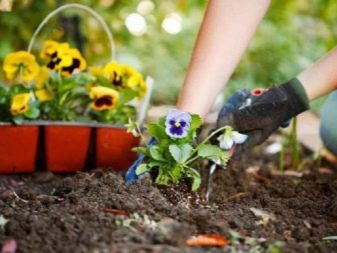

Possible problems
All problems, diseases of petunia "Starry Sky" are caused, first of all, by improper care. How to avoid flower diseases?
- For the prevention of diseases or in the presence of signs of damage, it is necessary to regularly treat the leaves with special chemical compounds, having previously studied the instructions.
- If the petunia receives a lot of moisture and light, the leaves may turn yellow, the buds and flowers will begin to fall off. Adjust watering, do not get carried away with feeding, shade the location of the petunia.
- Make sure that when watering, leaves and flowers do not get wet. Watering should be done only at the root.
- The leaves are wrinkled, darkened - saturate the roots with moisture, they simply do not have enough water or the petunia is infected with viruses, examine the flower carefully.
Petunia "Starry Sky" has become popular among amateur and professional flower growers. This variety came to us from Europe quite recently. The reasons for success are simple: unpretentiousness in nutrition and care, abundant unusual flowering. You can decorate a balcony, window sill, plant it in elegant flowerpots or decorate the walls with hanging pots.
If you find an error, please select a piece of text and press Ctrl + Enter.

Stars on earth! For the first time she planted a petunia "Starry Sky" or, as it is sometimes called, "Starry Night".
How happy I am with her! She is the decoration of my greenhouse, because hangs at the entrance to it, and the greenhouse itself stands next to the house and the kitchen. And as soon as I go out, she always catches my eye.
Starry sky in the greenhouse With its beauty, uniqueness, unpredictability of the colors of each flower (patterns on flowers never repeat), it cheers me up. I want to watch and watch ...
Night sky
At the exhibition in the spring, I first bought a pill with a shank, and then put it in a pot and hung it in the greenhouse.
In addition to soil, I added sand, long-acting AVA fertilizer and moisture-retaining granules to the pot.
Starry sky But all the same - it is hot in the greenhouse, even though the petunia hangs at the very entrance, there is little earth in the pot, incl. you have to water it twice a day.
If you move it outside, you can water it once every three days. I water only at the root, trying not to get on the flowers.
Starry night I think that in the very heat it will have to be removed from the greenhouse, tk. petunia "Starry sky" loves partial shade, ie flowers will be more contrasting. The light should be bright but diffused. For good development and abundant flowering, daylight hours are required: 12 hours a day.
Although the air temperature during the day is permissible up to 38 ° C (mine is much warmer ...), but for the formation of white spots, a temperature difference is necessary. At least 10 - 15 ° C.
I feed petunia once every two weeks with a complex water-soluble fertilizer for flowering plants (1 tablespoon of fertilizer per 10 liters of water).
It has been blooming with me for two months now and, I hope, it will bloom all summer. This beauty has the ability to form almost continuous buds, which is why the flowering is so long.
The flowers are dark blue, with a violet tint, on their background there is a spotted white pattern in a scattering. The color of the flowers varies depending on the conditions of detention.
Starry sky without temperature difference At first, I had it hung in the center of the greenhouse and there was more blue in the flowers, and when it was weighed to the edge, the flowers became almost white.
Yes, and the last days there was a cold snap, and I closed the door to the greenhouse. And in order for the drawing to be contrasting, a significant difference between day and night temperatures is necessary.
Petunia branches well, grows in a small bush. I cut off the fading with scissors.
Now I will have the starry sky all summer, sorry, not always ...
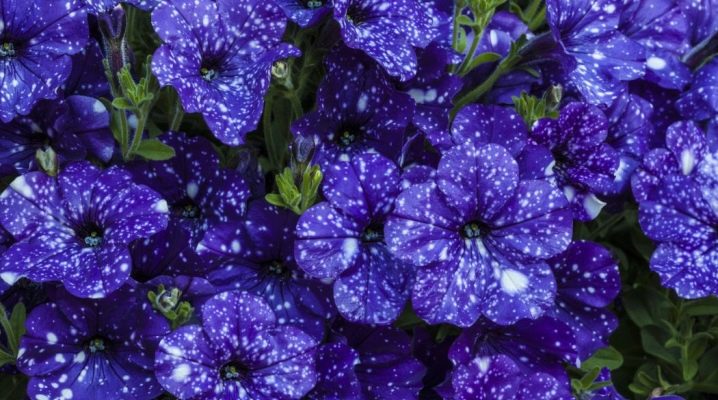
Petunia with the romantic name "Starry Sky" is one of the hybrid species artificially bred by breeders. You can often find other names for this one-year-old garden plant, charming with its beauty - "Night Sky" and "Starry Night". The flower received such names due to its color - on a violet-blue background, like small stars in the sky, small white specks are scattered. This variety of petunia is not difficult to grow, but it always looks very impressive, for which it received widespread recognition and love of gardeners.


Description of the variety and characteristics
A compact ampelous plant up to 30 cm high. In young specimens, the stems are erect, but as they grow, they sag under their own weight. The maximum length of the shoots is 50 cm.
The stems are densely covered with small oval-shaped leaves. The plates have a rough surface, slightly pubescent with hairs. The bush is characterized by a natural spherical shape with a diameter of 40-45 cm.
The root system is well developed. Underground shoots are highly branched, in adult plants they are buried by 10-12 cm.
Blooming petunia The stormy sky is continuous. It lasts from 70 to 100 days, depending on the conditions of detention. The variety belongs to large-flowered petunias. However, the number of buds directly depends on the nutritional value of the soil and the degree of illumination.
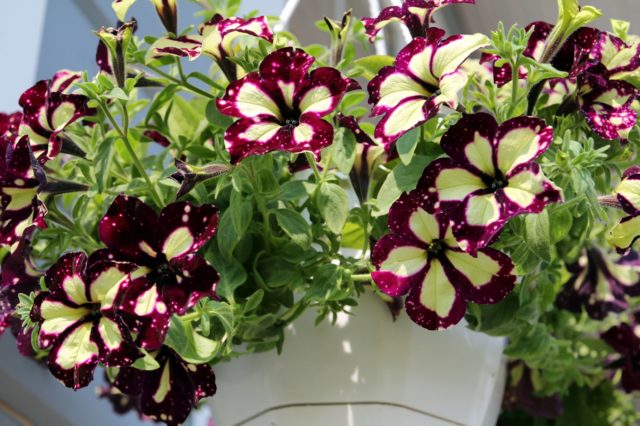 Petunia blooms in late May and withers in August
Petunia blooms in late May and withers in August
The opened buds reach 8 cm in diameter. The flowers are maroon or cherry, six-petaled. In the photo of a vegetative petunia Stormy sky, light spots are noticeable. This is a characteristic feature of hybrid varieties. If you grow a bush in a well-lit place, the spots grow and merge with each other.
In the early stages of flowering, the petals are dark. Later they brighten, become crimson, and the spots on them are cream or yellow.
The smell of flowers is very weak. It can be felt from a distance of 4-5 cm from the bush.
Variety Stormy sky is resistant to adverse weather conditions. The plant continues to bloom in extreme heat and during prolonged rains.
Petunia is sensitive to cold. Therefore, if summer is accompanied by a decrease in air temperature, the container with a flower must be brought into the room.
Petunia can be grown in many regions of the Russian Federation. The variety Stormy sky is recommended for the middle zone and the southern part of Russia. In regions with unfavorable weather conditions, the plant needs more careful care.
The variety is resistant to many diseases. Petunias Stormy sky are insensitive to the causative agent of white rot and black legs. Powdery mildew rarely occurs on the flowers.
Pest resistance is less pronounced. When grown outdoors, thrips, spider mites or aphids sometimes grow on petunias. Therefore, preventive treatment of the bushes is recommended.
Overview of the variety Stormy sky:
Description and features
The color of flowers depends on watering, soil and light. The plant grows as a small bush, blooms for two to three months and is usually grown in hanging baskets and pots. This is a fairly compact flower, but its shoots reach one meter and are strong enough, and buds are formed on each shoot.
There are varieties of petunias that can only be bred vegetatively, and this species belongs to them. Her seedlings can be bought at garden stores, and in the fall, the bushes should be trimmed and stored in a cool room. Spring is the best time for cuttings.
Quick landing guide
Propagation of petunia Starry sky should only be cuttings. The method is not difficult, even a beginner can handle it.The main thing is to follow the basic recommendations.
To do this, you need to cut off a stalk with two nodules ten centimeters long. Remove all flowers and leaves, immerse the cutting in water and leave for two weeks. This time is enough for the first roots to appear and the stalk can be immersed in the ground. After another fourteen days, place the shoot in a pot in a shaded place to start the rooting process.
To move a flower to a permanent place of residence in open soil, cloudy weather should be chosen. It is advisable to take action in the afternoon. We prepare square holes with sides of ten centimeters.
We maintain a distance of about thirty centimeters between the holes. We transfer young seedlings from the container, without damaging the earthen lump, into the ready-made recesses.
Cover the soil with a layer of mulch. This is necessary to speed up the rooting process. For these purposes, peat, or humus, is suitable.
And of course, don't forget about watering.

What soil is needed for petunia Starry sky?
The soil of the following composition is optimal for petunia: in two parts peat, in two parts consisting of sod land, in two parts from leafy soil, two parts of humus, and one part of sand. Since the culture loves light soils, it is advisable to sift the soil and provide moisture immediately before planting.
A vegetative petunia Starry sky needs a loose soil with sufficient air circulation, which should not be compacted as a result of abundant watering, but at the same time maintain a moisture balance.
When it comes to sun exposure, petunia loves diffused, soft light. Therefore, semi-darkened areas are favorable for planting.
However, for lush flowering and proper development, a day of light with a duration of about thirteen hours is required. When there is a lack of lighting, additional lighting is used.
How to provide proper care for the Starry Sky vegetative petunia variety?
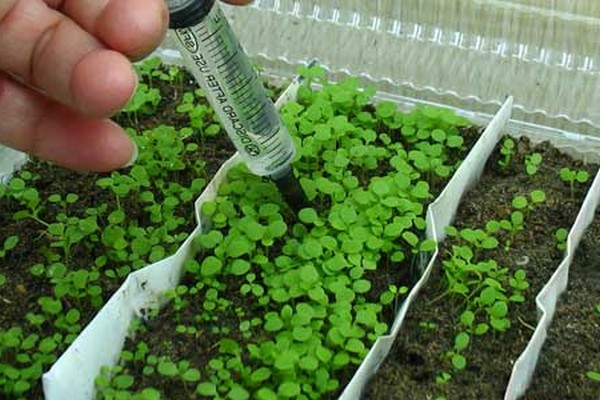
When we see a beautiful flower, we often think that it requires difficult care. In the variant with petunia, this is not at all the case. However, the basic rules should be followed.
The flower will feel great at daytime temperatures not exceeding thirty-eight degrees, at night it is desirable that the temperature does not drop below ten degrees. After all, it is the temperature difference that is required for the formation of white blotches.
Humidity mode
Once we have placed the petunia in the pot, it is important to ensure regular watering. You need to water directly under the root, avoiding contact with buds or flowers
- We water it as the soil dries out. And this usually happens every three days.
- Watering the variety of petunias Starry sky is better with settled water at room temperature.
Like all crops, Starry sky petunia needs feeding. For petunias growing in a confined space, such as a flowerpot or flowerpot, top dressing is most important.
- Primary fertilization is carried out with mineral phosphorus fertilizer. Such feeding is necessary in order for the root system to form correctly. You can prepare the solution yourself. For this we need: a tablespoon of super phosphate and ten liters of ordinary water. By mixing the ingredients, we get a ready-to-use composition.
- Secondary feeding is beneficial to produce after twenty to thirty days. For this case, either ready-made complex or nitrogenous dressings are suitable.
- In the future, the plant can be fed every two weeks, but not more often than once every ten days.
- Accordingly, the total number of dressings per month in our country should not exceed four.
- By the end of the spring period, the ripening of the buds usually occurs, it is this time that is the best for feeding with potassium.
- Throughout the entire flowering period, our cosmic beauty should be fertilized no more than two times.
- The solution is prepared in the same way as for phosphorus fertilizer.
Another, even simpler, feeding option during this period is ready-made complex fertilizers for flowering crops. Preparing them, following the instructions, will not be difficult. It is enough just to dilute the composition in water, observing the indicated proportions. It is enough to perform such a manipulation once every fifteen days.
How to plant with seeds
First you need to tackle seedlings.
Growing seedlings
Petunia is quite unpretentious and grows well outdoors. But before planting it in open ground, it is necessary that the seedlings get used to the conditions of open ground for some time, it needs to be taken out for a while outside, at least for a week.
Flowers must be protected from the wind. If it is a container petunia, then drainage must be poured at the bottom. For these purposes, floor vases, balcony boxes are suitable. The plant blooms 65-92 days after planting the seeds.
Preparation of soil and planting material
Petunia is also propagated by seeds, which are sown in seedling boxes in early spring. For this purpose, it is better to use granular seeds, they are more palpable in the hands, which allows you not to overdo it with their quantity, because of which the seedlings will be located very closely to each other. These seeds allow you to sow them at the same distance from each other.
The material is sown into a special multicomponent substrate.
Sowing dates
Before sowing, the land must be allowed to warm up at room temperature. It needs to be poured with settled water with the addition of potassium permanganate. After sowing, you need to stretch the cling film over the box and remove it only for airing and spraying.
The seedlings are grown at room temperature and should emerge in 7-10 days. Water the sprouts with a syringe strictly at the root, and dive at a height of 2 to 3 centimeters.
How to plant
When planting, it is necessary to remove faded flowers in a timely manner. This is a fairly drought-resistant plant. Instances that grow in containers require frequent watering. And the leaves can turn yellow from insufficient irrigation, improper soil acidity.
Airing
Seeds that have hatched do not need to be watered. After the shoots get stronger, the film and glass are removed and the plant is allowed to ventilate. Over time, the time for airing is increased, due to which the plant adapts to the environment. And when the third leaf appears, the film can be removed completely.
Dive
Seedlings can be dived when 2-3 leaves appear on the petunia. Diving consists in separating plants into separate containers. The bushes are transferred into small plastic cups, and as the flower grows, the earth must be added in parts.
Hardening
When the seedlings are planted in pots, they begin to harden them, accustom them to a temperature of 10 to 15 degrees. To do this, they transfer it to a cold place for a while or open a window above it. This period of time should last no more than 15 minutes, gradually increasing it.
Topping
Pinching is carried out in order to form a beautiful bush, and is performed at the stage of formation of the 4-5th leaf.
Landing in open ground
To plant a plant in open ground, you need to consider some key points:
- the plant loves light;
- does not like stagnant fluid;
- it is necessary to feed once every two weeks.
Seat selection
When choosing a place for planting, it should be borne in mind that petunia loves bright, but diffused light or partial shade, and the plant should be at least 12 hours under illumination. If the culture cannot be provided with such lighting, then it is necessary to install a phytolamp.
Soil requirements
The soil for planting is multicomponent, consisting of peat, sand, turf and leaf land. You can also add wood ash.
Landing scheme
Seeds must be planted on time. After preparing the soil, the material is laid out in moistened soil.There is no need to deepen or cover with soil. You need to create a greenhouse and cover the seeds with foil. Plants need to be planted thirty centimeters from each other. A flower is planted as follows:
- You need to make a markup for planting.
- Seedlings are removed from the container carefully so as not to damage the root system.
- Form the holes in which the seedlings are laid out.
Timing
In order to correctly determine the timing of planting seedlings in the ground, you need to know the timing of sowing seeds, germination, the growth period of seedlings and the immediate timing when the seedlings are ready for transplanting into the ground.
List of sources
- .
Pests and diseases
The variety is insensitive to infections. Fungal diseases appear only due to high humidity. If symptoms of blackleg or powdery mildew are detected, the affected shoots should be removed. The rest of the bush is treated with fungicides and isolated from other plants.
With improper care, petunia leaves and flowers turn yellow and dry
The reason for premature wilting is the lack of minerals in the soil. Another factor is the increased acidity of the soil.
For the prevention of pests, the bushes are treated with insecticidal preparations when transferred to the street after wintering. Repeated spraying is carried out every three to four weeks, including during flowering.
At the initial stage of flowering, petunias attract bees and hornets. They do not pose a threat to the plant, therefore, they do not take measures to combat these insects.
If the bush starts to wilt or does not bloom well, you need to check the soil for the presence of nematodes. If signs of parasite infestation are detected, the petunia should be dug up. The roots are cleaned of old soil and soaked in an antiseptic solution. After that, the plant is planted in a new container with sterilized soil.
Description of the variety
The Starry Night petunia variety belongs to the Solanov family. In the wild, petunia is a perennial shrub that grows in the territories of South and North America, growing up to a meter in height. To date, biologists know over 40 different types of petunias.
Petunia "Starry Night" is quite compact, however, when planted in hanging baskets, the shoots of the plant can reach a length of up to one meter. The flower bushes well and grows quickly. The shoots of the plant are strong, they actively grow due to abundant branching. Moreover, on each shoot in the process of growth, flower buds are constantly formed in large quantities. The leaves of the petunia are velvety to the touch, have a bright green saturated color and there are a lot of them on the shoots, therefore, visually, the flower creates the feeling of a volumetric ball.
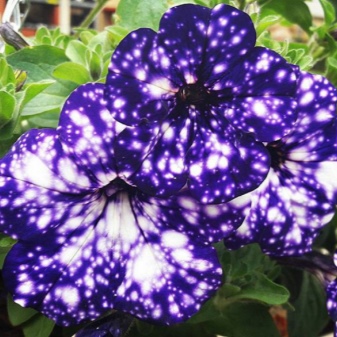
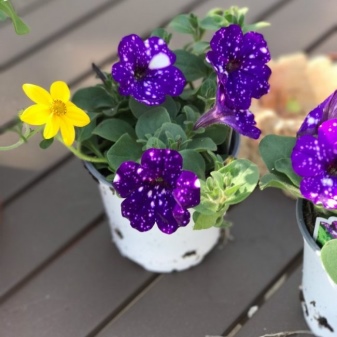
The flowering of this annual in the warm season is long and continuous, it lasts from three to five months - from early spring to autumn. Each flower has five petals, widened and rounded on the outside.
The optimum temperature for the "Starry Sky" is the range from +10 to +37 degrees. It is this temperature range that contributes to the appearance of white spots on flowers. The variety "Night Sky", due to its high decorativeness, looks very beautiful in any conditions: in a flower bed, in a hanging pots, when decorating a balcony.


Conclusion
The name of the petunia Night sky speaks for itself. In these amazingly beautiful flowers, you can see the starry sky on a clear night. White spots of various sizes are scattered against a dark purple background. The color intensity depends on the air temperature and lighting. In partial shade, the flowers retain a rich shade longer, and in bright daylight, more white large spots appear.
The cultivar is grown in a vegetative way using cuttings. Ready-made seedlings are purchased in specialized stores or harvested independently from existing bushes.It is simple to care for petunia: it is enough to maintain an optimal level of humidity, apply supportive fertilizing, cut long branches and carry out a preventive examination.


